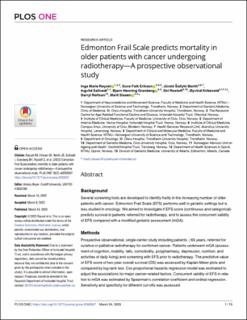| dc.contributor.author | Røyset, Inga Marie | |
| dc.contributor.author | Eriksen, Guro Falk | |
| dc.contributor.author | Saltyte Benth, Jurate | |
| dc.contributor.author | Saltvedt, Ingvild Tina | |
| dc.contributor.author | Grønberg, Bjørn Henning | |
| dc.contributor.author | Rostoft, Siri | |
| dc.contributor.author | Kirkevold, Øyvind | |
| dc.contributor.author | Rolfson, Darryl | |
| dc.contributor.author | Jordhøy, Marit Slaaen | |
| dc.date.accessioned | 2023-06-21T14:20:06Z | |
| dc.date.available | 2023-06-21T14:20:06Z | |
| dc.date.created | 2023-03-28T08:48:54Z | |
| dc.date.issued | 2023 | |
| dc.identifier.citation | PLoS One . 2023 Mar 24;18(3):e0283507. | en_US |
| dc.identifier.issn | 1932-6203 | |
| dc.identifier.uri | https://hdl.handle.net/11250/3072484 | |
| dc.description.abstract | Background: Several screening tools are developed to identify frailty in the increasing number of older patients with cancer. Edmonton Frail Scale (EFS) performs well in geriatric settings but is less studied in oncology. We aimed to investigate if EFS score (continuous and categorical) predicts survival in patients referred for radiotherapy, and to assess the concurrent validity of EFS compared with a modified geriatric assessment (mGA). Methods: Prospective observational, single-center study including patients ≥65 years, referred for curative or palliative radiotherapy for confirmed cancer. Patients underwent mGA (assessment of cognition, mobility, falls, comorbidity, polypharmacy, depression, nutrition, and activities of daily living) and screening with EFS prior to radiotherapy. The predictive value of EFS score of two-year overall survival (OS) was assessed by Kaplan-Meier plots and compared by log-rank test. Cox proportional hazards regression model was estimated to adjust the associations for major cancer-related factors. Concurrent validity of EFS in relation to mGA was estimated by Spearman`s correlation coefficient and ordinal regression. Sensitivity and specificity for different cut-offs was assessed. Results: Patients' (n = 301) mean age was 73.6 (SD 6.3) years, 159 (52.8%) were men, 54% received curative-intent treatment, breast cancer (32%) was the most prevalent diagnosis. According to EFS≥6, 101 (33.7%) were classified as frail. EFS score was predictive of OS [hazard ratio (HR) 1.20 (95% confidence interval (CI) 1.10-1.30)], as was increasing severity assessed by categorical EFS (p<0.001). There was a strong correlation between EFS score and number of geriatric impairments (Spearman`s correlation coefficient 0.77). EFS cut-off ≥6 had a sensitivity of 0.97 and specificity of 0.57 for identifying patients with minimum two geriatric impairments. Conclusion: EFS predicts mortality in older patients with cancer receiving radiotherapy, and it is a quick (<5 minutes) and sensitive screening tool to identify patients who may benefit from a geriatric assessment. Copyright: © 2023 Røyset et al. This is an open access article distributed under the terms of the Creative Commons Attribution License, which permits unrestricted use, distribution, and reproduction in any medium, provided the original author and source are credited. | en_US |
| dc.language.iso | eng | en_US |
| dc.rights | Navngivelse 4.0 Internasjonal | * |
| dc.rights.uri | http://creativecommons.org/licenses/by/4.0/deed.no | * |
| dc.subject | Activities of Daily Living; | en_US |
| dc.subject | Aged; | en_US |
| dc.subject | Female; | en_US |
| dc.subject | Frail elderly; | en_US |
| dc.subject | Frailty*; | en_US |
| dc.subject | Geriatric Assessment; | en_US |
| dc.subject | Humans; | en_US |
| dc.subject | Male; | en_US |
| dc.subject | Neoplasms; | en_US |
| dc.subject | radiotherapy; | en_US |
| dc.subject | Prospective Studies; | en_US |
| dc.title | Edmonton Frail Scale predicts mortality in older patients with cancer undergoing radiotherapy-A prospective observational study | en_US |
| dc.title.alternative | Edmonton Frail Scale predicts mortality in older patients with cancer undergoing radiotherapy-A prospective observational study | en_US |
| dc.type | Peer reviewed | en_US |
| dc.type | Journal article | en_US |
| dc.description.version | publishedVersion | en_US |
| dc.rights.holder | Copyright: © 2023 Røyset et al. This is an open access article distributed under the terms of the Creative Commons Attribution License, which permits unrestricted use, distribution, and reproduction in any medium, provided the original author and source are credited. | en_US |
| dc.source.volume | 18 | en_US |
| dc.source.journal | PLOS ONE | en_US |
| dc.source.issue | 3 | en_US |
| dc.identifier.doi | 10.1371/journal.pone.0283507 | |
| dc.identifier.cristin | 2137415 | |
| dc.relation.project | Stiftelsen Dam: 19-3656 | en_US |
| dc.relation.project | Kreftforeningen: 247593001 | en_US |
| dc.relation.project | Sykehuset Innlandet HF: 150356 | en_US |
| cristin.ispublished | true | |
| cristin.fulltext | original | |
| cristin.qualitycode | 1 | |

